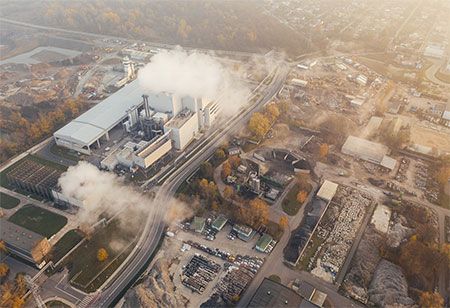Enhancing Ecological Practices in Titanium Dioxide Production: Methodologies and Innovations
By Simran Kaur, Content Writer

Titanium dioxide (TiO2), which may look like an ordinary white powder, is a technological marvel with many applications. From making our paints brighter to shielding us from harmful UV rays, TiO2 plays a crucial role in everyday life. But how is titanium dioxide manu- factured? Let's delve into the fascinating world of titanium dioxide production.
There are two main types of titanium dioxide manufacturing processes: the sulfate process and the chloride process. Each boasts its own advantages and environmental considerations.
How Is Titanium Dioxide Manufactured
Let’s explore the TiO2 process and how it works:
The Sulphate Process
The sulfate process, established for over a century, utilizes ilmenite, a mineral containing iron and titanium oxides, as the primary source material. The key steps to making it are:
- Crushing and Grinding: The ilmenite ore undergoes a thorough crushing and grinding process to achieve a fine powder, maximizing surface area for subsequent reactions.
- Sulfuric Acid Digestion: The finely ground ilmenite is treated with concentrated sulfuric acid. This acidic environment dissolves the titanium component, forming a titanium sulfate solution. Iron and other impurities remain behind as insoluble residues.
- Hydrolysis and Calcination: The titanium sulfate solution undergoes hydrolysis, reacting with water to form a titanium hydroxide precipitate. This precipitate is then calcinated, a high-temperature heating process that transforms it into titanium dioxide powder.
- Pigment Upgradation: The resulting TiO2 powder may require further processing, such as grinding and surface treatment, to achieve the desired properties for specific applications like paints or plastics.
The Chloride Process
The chloride process, a more recent development, offers several advantages. It is generally considered more efficient and can produce higher-quality TiO2 pigments. Here's a glimpse into its workings:
- Chlorination: Rutile, a titanium dioxide mineral with a higher titanium content than ilmenite or titanium slag, a byproduct of other metal extraction processes, serves as the starting material. It is subjected to chlorination, where it reacts with chlorine gas at high temperatures to form titanium tetrachloride (TiCl4), a volatile liquid.
- Purification: The TiCl4 vapor undergoes a meticulous purification process to remove any impurities affecting the final product's quality.
- Oxidation: The purified TiCl4 is then oxidized, typically with oxygen, to convert it into titanium dioxide. This reaction can occur through various methods, including hydrolysis or flame hydrolysis.
- Post-Processing: Similar to the sulfate process, the obtained TiO2 powder may undergo further processing to meet specific application requirements.
Both processes have environmental aspects that require careful management. The sulfate process generates large quantities of iron sulfate, a byproduct that needs proper disposal. The concentrated sulfuric acid used poses potential risks if not handled meticulously.
On the other hand, the chloride process utilizes chlorine gas, which raises concerns about potential leaks and its impact on the environment. However, modern plants employ robust emission control systems to minimize these risks.
The TiO2 manufacturing process is a complex mix of chemistry and engineering. Manufacturers strive to optimize processes for efficiency, quality, and environmental impact. Here are some additional aspects to consider:
- Crystal Structure: TiO2 exists in different crystal structures, namely rutile and anatase. The chosen process and subsequent modifications can influence the final crystal form, impacting the material's properties. Rutile is generally preferred for its superior performance in many applications.
- Surface Treatment: TiO2 particles can be coated with various materials to enhance specific functionalities. For instance, a silica coating can improve dispersibility in paints, while alumina coating might enhance UV resistance.
- Sustainability: Ongoing research focuses on developing cleaner and more sustainable production methods. Alternative feedstocks and less hazardous reagents are being explored to minimize environmental impact.
 Conclusion
Conclusion
As the demand for TiO2 continues to rise, driven by its versatility and growing app- lications, the focus will likely shift towards more sustainable and efficient titanium dioxide process practices. Research in areas like utilizing alternative feedstocks, such as titanium-bearing waste materials, and ex- ploring greener alternatives to chlorine gas in the chloride process holds promise for a brighter future for TiO2 manufacturing.
In conclusion, the tio2 process production is a fascinating journey that transforms raw material into a wonder material with countless applications. By understanding the processes involved and the ongoing efforts towards sustainability, we gain a deeper appreciation for the science and technology that bring this remarkable white powder to life.
Frequently Asked Questions
How is titanium dioxide manufactured?
Using high temperatures and chemical reactions, the TiO2 manufacturing process chemically transforms titanium-rich ores into titanium dioxide pigment through extraction, purification, and pigment formation.




